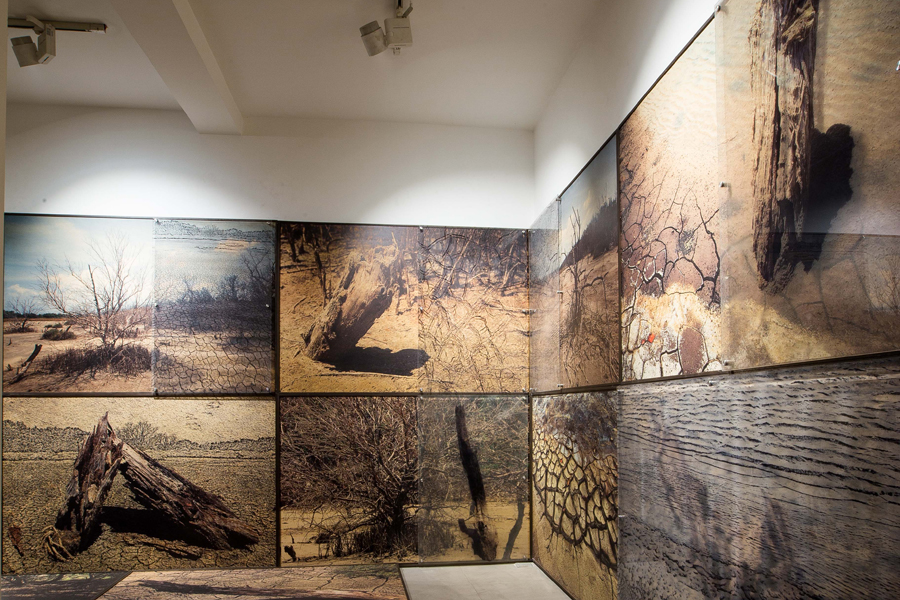

|
CRITICAL MEMBRANE SOLO PROJECT CURATORIAL ADVISER TO THE PROJECT: RANJIT HOSKOTE SUPPORTED BY M S SWAMINATHAN RESEARCH FOUNDATION INDIA NOVEMBER 2016 - FEBRUARY 2017 EXHIBIT 320 NEW DELHI |
|
 | |
|
'Critical membrane' is an inquiry into the less explored, dynamic, fragile and fast depleting mangrove ecosystems of India. The mangrove belt is the 'membrane' between land and sea and is disappearing at faster rates than any other ecosystem on Earth. The mangroves provide a preview of the challenges ahead for ecosystems and biodiversity hotspots across the planet. Documented extensively in degraded mangrove belts across India, these decaying ecosystems speak volumes about a living vicious cycle of depredation that is the tale of 21st century globalization.The landscapes speak chronicles of past histories, politics, the environment and economics of consumption. The ongoing series of work combines and encompasses phases of research, expedition and documentation into comprehensive projects, through a robust interaction with Coastal and Mangrove ecosystems of India that spans across several media and traverses notions of selfhood, nature, ecology, and sustainability. Mangrove ecosystems become an entry point to various enquires: artistic, scientific, philosophical, and metaphorical. | |
|
'Critical Membrane' marks the current phase of Sonia Mehra Chawla's ongoing project, 'Scapelands', and her close engagement with the present and future of India's endangered mangrove systems. Spanning prints, photographs, video works and installations, this body of work addresses itself to the mangrove ecologies of India's Coromandel and Malabar coasts, located respectively in the states of Tamil Nadu and Kerala. The artist's exploration of these regions has been inspired by an awareness of impending ecological catastrophe. The mangroves, an osmotic border between land and sea, are under grave threat from direct human interference as well as the cataclysmic shifts in a natural world disordered by the long-term effects of technological activity. In Mehra Chawla's elegiac images of dying mangroves and shrinking wetlands, we find the chronicle of many deaths foretold. 'Critical Membrane' reminds us of the epochal costs that humankind must pay for its economic expansionism, a logic set in motion during the industrial revolution and supported by the contractarian ideology and extractive practices of global capital. As the philosopher Akeel Bilgrami has memorably phrased it, this paradigm has replaced nature with natural resources, communities with populations, and the knowledge to live by with an expertise to rule by. This instrumentalisation of our lifeworld follows from the industrialisation-era model of pitching humankind against nature. By contrast, research across a range of disciplines has encouraged us, with increasing urgency in recent decades, to embrace the understanding that we inhabit complex webs of stimulus and response, intervention and repercussion. We are bound together by interrelationships that require sensitive calibration but are treated, all too often, with shockingly callous and ultimately self-destructive disregard. Suggestive of the fluid boundary between self and other, species and habitat, the title of Mehra Chawla's exhibition alerts us to the need to subject our visions of anthropocentric, nature-depletive development,to critique. The artist's practice combines a commitment to the processes of research and activism with a fidelity to the poetics of the artwork. In bearing witness to an unprecedented moment in the history of the planet, she brings together a variety of impulses, ranging from microscopic details of bacterial and microbial cultures to documentary cinematic studies of marginalised groups whose eco-sensitive occupations have suffered as a result of the decline in their environment. While I have argued, previously, that there is a strongly solitary, expeditionary quality to Sonia Mehra Chawla's projects, I would also draw attention to the equally vital collaborative and empathetic aspects of her work. Her thread through the labyrinth is woven together with the threads of other questors, other survivors, other celebrants of resistance. - Ranjit Hoskote http://www.aestheticamagazine.com/yinchuan-biennale-2016/ |
|
 |
 |
 |
||
 |
 |
 |
||
 |
 |
 |
||
 |
 |
 |
||
 |
 |
 |
||
 |
 |
 |
||
 |
 |
 |
||
 |
 |
 |
||
 |
 |
 |
||
 |
 |
 |
||
 |
 |
 |
||
 |
 |
 |
||
 |
||||